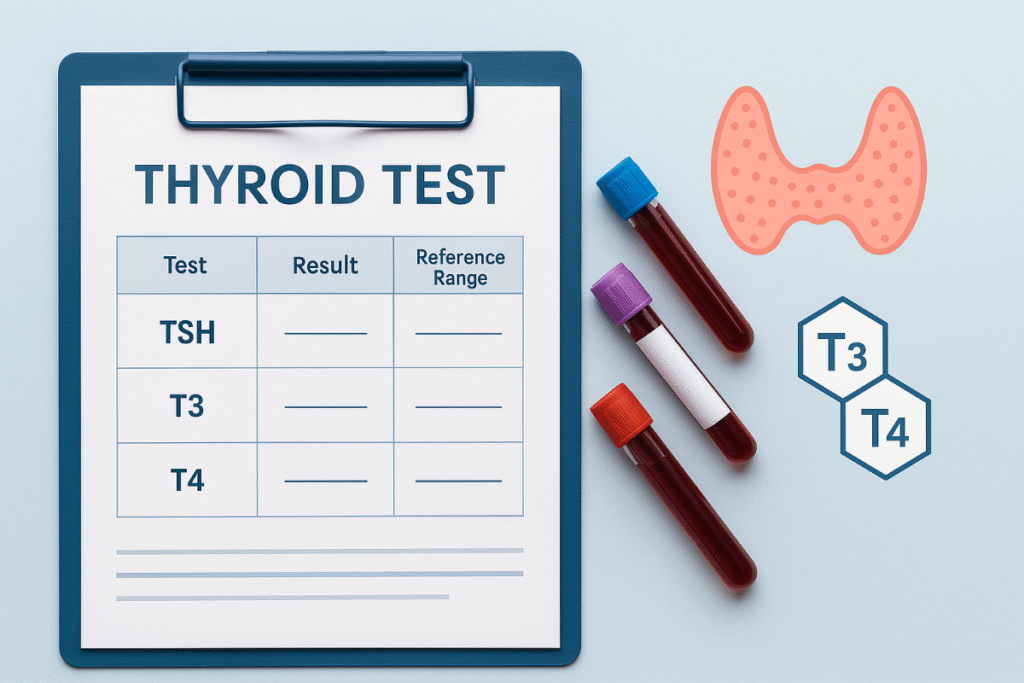It’s normal to wonder what mysterious acronyms like TSH, T3, or T4 mean if you’ve ever had blood work done and seen them on the report. In the doctor’s office, we all nod during the explanation, and when we get back in the car, we silently Google everything. Technical, perplexing, and rather frightening, thyroid testing can be like a foreign language.
But don’t worry. To understand your thyroid levels, you don’t need a medical degree. All you need is someone to explain it to you in plain, uncomplicated language. Let’s do that, then.
First things first: Anyhow, what’s the thyroid?
Let’s take a little look back. Located immediately below the Adam’s apple at the front of your neck, the thyroid is a small, butterfly-shaped gland. Yes, it is small. Unimportant? Not even.
Your metabolism is maintained in large part by this gland. It controls your heart rate, body temperature, calorie burning efficiency, and even your thoughts and sleep patterns. T3 (triiodothyronine) and T4 (thyroxine) are the main hormones it secretes to achieve all of this.
Your body goes into overdrive if you have hyperthyroidism, or an overactive thyroid. Hypothyroidism causes it to run too slowly, which makes everything seem slow as well. To determine how effectively your thyroid is functioning, testing is necessary.
Discover the Key Players: TSH, T3, and T4
This is the group that shows up on the majority of thyroid panels. Think of them as members of a complicated hormonal family, always influencing and interacting with one another.
1. TSH (hormone that stimulates the thyroid)
TSH isn’t actually a thyroid hormone. The foreman is comparable. The pituitary gland, located deep within your brain, produces it, and its sole purpose is to tell your thyroid how hard to work.
TSH rises in response to a drop in thyroid hormone levels, “Speed it up down there!”
TSH takes a backseat when hormone levels become too high, saying, “Whoa, slow it down.”
Normal Range for TSH
- between 0.4 and 4.0 mIU/L, though test results can vary slightly.
- Overactive thyroid equals lower TSH. Underactive thyroid means higher TSH.
What a High TSH May Indicate:
Your thyroid does not generate enough hormones, which is known as hypothyroidism. Your body is struggling to meet the demands of the hormones. You can have an autoimmune condition called Hashimoto’s thyroiditis.
What a Low TSH May Indicate:
You have hyperthyroidism, or an overactive thyroid. Thyroid nodules, Graves’ disease, or even too much thyroid medication could be the cause.
In summary, TSH is the first indicator your doctor looks for when assessing the health of your system. However, that is just a portion of the story.
2. Thyroxine (T4)
We are now discussing the actual hormones that are produced by your thyroid. The hormone that your thyroid produces the most of is called T4, or the storage form. Although it isn’t very active on its own, it is transformed into the more “powerful” hormone T3.
T4 blood tests come in two varieties:
- Total T4: Calculates the total amount of T4 in your blood, including that which is bound to proteins.
- Free T4 (FT4): Capable of performing its function, it only measures the active form when it is detached.
- The Free T4 test is typically preferred by doctors because it gives a more accurate picture of what your body can truly use.
- Free T4 normally falls between 0.8 and 1.8 ng/dL, depending on the laboratory.
What a High T4 Could Indicate:
- Overproduction of hormones by the thyroid is known as hyperthyroidism.
- overuse of synthetic thyroid hormone medications.
- Graves’ illness.
- What a Low T4 Could Indicate:
- Sluggish thyroid, or hypothyroidism.
- thyroiditis caused by Hashimoto.
- problems with the pituitary gland (inadequate TSH production).
T4 is similar to the amount of product that is stored on the shelves of your thyroid. However, the amount that is converted to T3 is what matters most.
3. Triiodothyronine, or T3
The action hero is T3. In actuality, this hormone is what makes your body work.T3 plays a major role in digestion, heart rate, mood, and energy.
Although your body converts T4 to T3 in your liver and other tissues, your thyroid produces some T3 directly.
Similar to T4, T3 can be quantified as
- Total T3 (free + bound)
- Free T3 (FT3), or the active ingredient
- The normal range for free T3 is 2.3 to 4.2 pg/mL, albeit this varies from test to lab.
If T3 Is Higher:
often an indication of hyperthyroidism. You can experience sweating, anxiety, jitters, nervousness, or weight loss without understanding why
If T3 Is Low:
Hypothyroidism could be your condition.
Or your body is just not doing a good job of converting T4 to T3 (also known as euthyroid ill syndrome or low T3 syndrome).
Although T3 is significant, TSH and T4 are still the main indicators that most physicians consider. If your TSH is “normal,” yet you don’t feel well, ask for Free T3. A major game-changer, perhaps.
Bonus Round: Additional Thyroid Examinations You Might Learn About
Although TSH, T3, and T4 are the mainstays, your doctor may also recommend other tests, especially if they suspect autoimmune thyroid disease.
1. Antibodies to thyroid
- Hashimoto’s illness is characterized by increased anti-thyroid peroxidase (TPO) antibodies.
- Thyroid-stimulating immunoglobulin (TSI) or TRAb: Increased in Graves’ disease.
- These are unintentional attacks on your thyroid by your immune system. They are helpful in identifying the underlying cause of thyroid problems.
2. T3 in reverse (rT3)
Though less frequent, this one should be mentioned. This T4 derivative is essentially inert, but it can suppress active T3 if levels rise too high, which is frequently the result of long-term stress, disease, or malnutrition.
How Everything Works Together: How to Read Your Thyroid Panel Expertly
Suppose your lab results look like this:
- TSH: 5.2 (high)
- Free T4: 0.7 (low)
- T3 free: 2.1 (low)
That trend is typical of hypothyroidism. Your pituitary is exerting extra effort to stimulate your thyroid, which is not functioning well.
Now turn that around:
- TSH: 0.1 (low)
- Free T4: 2.5 (high)
- Free T3: 5.0 (high)
Everything is geared up here. You most likely suffer from hyperthyroidism. Sometimes, though, things are more complicated—for example, normal TSH with low T3.
Here’s where a competent doctor goes beyond the stats and pays attention to your symptoms.
Why It Matters: Hormones Aren’t the Only Factor Here
- Your thyroid can affect everything, including your mood, menstruation, and hair thickness.
- Thyroid imbalance is the cause of fatigue, anxiety, weight gain, sadness, dry skin, and impaired mental clarity.
- The full picture can be obtained by obtaining a complete thyroid test, which includes TSH, Free T4, Free T3, and antibodies. Too many clinics only do a TSH test and stop there. Advocate for the more thorough examinations if you’re not acting like yourself. You are the only one who truly understands your body.
Conclusion:
You are simply misunderstood (perhaps by your thyroid), not insane. Thyroid issues can be misleading. They don’t always show themselves to everyone in the same way. A person who sleeps all day will put on fifteen pounds. Another will feel twitchy and nervous but unable to concentrate. There is no one-size-fits-all solution.
Understanding the true meaning of TSH, T3, and T4 gives you the authority to take charge of your own health, ask more insightful questions, and challenge a “normal” test result that doesn’t feel quite right to you.
Don’t panic the next time your labs show up in your inbox amid a sea of numbers. You’re prepared. You’re using thyroid-speak now.
FAQs:
A TSH test measures how much thyroid-stimulating hormone your pituitary gland is releasing. A TSH test helps doctors determine if your thyroid is underactive or overactive.
This may suggest subclinical hypothyroidism. This may mean your thyroid is beginning to slow down, even if your hormone levels haven’t dropped yet. Over time, it might progress to full hypothyroidism.
T3 is the active thyroid hormone that boosts metabolism, heart rate, and temperature. T3 is the hormone your body uses the most directly, and low T3 often explains fatigue and weight gain.
T4 is the storage hormone, while T3 is the active form. T4 gets converted into T3 in the liver and other tissues. In short, both are important, but T3 does most of the “work.”


